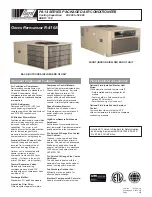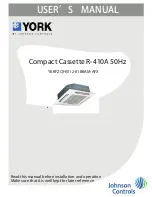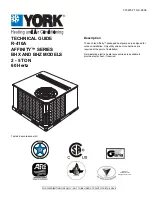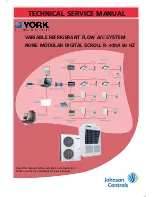
OCH790 _84
8-2. Remote controller diagnosis
Refer to “Remote controller check” for MA remote controller system.
8-3. Remote controller trouble
8-3-1. M-NET remote controller systems
Symptom or inspection code
Though the content of operation is displayed on the re-
mote controller, some indoor units do not operate.
Cause
•
The power supply of the indoor unit is not on.
• The address of the indoor units in the same group or
the remote controller is not set correctly.
•
The indoor units connected in the other system are not
set in the same group by the remote controller.
•
The fuse on the indoor unit controller board is blown.
Though the indoor unit operates, the display of the remote
controller goes out soon.
•
The power supply of the indoor unit is not on.
•
The fuse on the indoor unit controller board is blown.
The display of the remote controller does not come up.
•
The power supply of the outdoor unit is not on.
•
The connector of transmission outdoor power board is
not connected.
•
The number of connected indoor units in the refrigera-
tion system is over the limit or the number of connected
remote controller is over the limit.
•
M-NET remote controller is connected to MA remote
controller cable.
•
The transmission line of the indoor/outdoor unit is short-
ed or down.
•
M-NET remote controller cable is shorted or down.
•
Transmission outdoor power board failure.
“Startup screen” keeps being displayed or it is displayed
periodically.
(“Startup screen” is usually displayed about 3 minutes after
the power supply of the outdoor unit is on.)
•
The power supply for the feeding expansion unit for the
transmission line is not on.
•
The address of the outdoor unit remains “00”.
• The address of the indoor unit or the remote controller
is not set correctly.
•
MA remote controller is connected to the transmission
line of the indoor/outdoor unit.
The remote controller does not operate.
•
The transmission line of the indoor/outdoor unit is con-
nected to TB15.
•
The transmission line of the indoor/outdoor unit is short-
ed down or badly contacted.
Inspection method and solution
Check the part where the abnormality occurs.
1. The entire system
2.
In the entire refrigerant system
3.
In same group only
4. 1 indoor unit only
In the case of the entire system or in the entire refrigerant
system
•
Check the self-diagnosis LED of the outdoor unit.
•
Check the items shown in the left that are related to the
outdoor unit.
In the case of in the same group only or 1 indoor unit only
•
Check the items shown in the left that are related to the
indoor unit.
















































